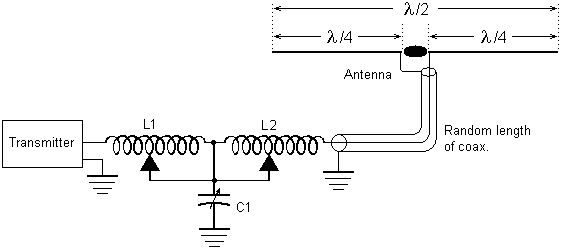Author: Frederick R. Vobbe, W8HDU
January 3, 2008
| Antenna 002: Tuned 1/2 Wave Dipole Author: Frederick R. Vobbe, W8HDU January 3, 2008 |
Suppose you want a random length of transmission line, or use a different type of transmission line. It is possible, provided that the radiation patterns and the takeoff angle meets your needs. There are two ways to do it. Using this formula, VF is the velocity factor of the cable being used. fMHz would be the frequency, (for example 7.100 megahertz). The line length is half wave, and can be doubled as necessary. So for eample, if you calculate and get a length of 91.5 feet, you could have a line 91.5 feet, 183 feet, 274.5 feet, and so on. You can calculate the length of line to match to the antenna. Keep in mind, however, if you calculate for 7.100 megahertz, but then QSY to 7.200 megahertz, all bets are off for the match! It may, or may not be within an acceptable VSWR range of your rig. A better way is to use a line tuner. This method allows you to use a random length coax and tune out the VSWR and match better to the antenna. A side benefit is if your antenna is not quite cut to your ideal frequency, you can tune out the VSWR problems. However, this will not help the radiation pattern of the antenna. Here is how it's done.  Use the formula in the Simple 1/2 wave antenna paper to calculate your 1/2 wave antenna. Two variable coils, L1 and L2, are placed in series with the hot side of an unbalanced line (coax). A variable capacitor, C1, is placed from the junction of the two coils to ground. Off the output of L2 you feed the coax, which can be 50 ohm or 75 ohm coax of random length. The combination of L1 and C1 form the matching for the TX to tuner, typically in the 50 ohm range to make the transmitter happy. The combination of L2 and C1 form the matching to the line. The R/L and can have some wide variations depending on the coax type and length. On a tuner I built in 1984 I used a 4" long piece of 2" round PVC pipe for the coil form. I wound a #18 silver wire around it. Using a gator clip connected to a strand of wire I could carefully tickle the coil to find the sweet spot. The capacitor was out of an old radio. For low band operation, a 10-350 pf variable seemed to work well. But for up in the 40 to 10 megahertz range, the value should be reduced. Warning: Never try to move or adjust a coil or capacitor when transmitting. High voltages or currents could be present, some of which could be lethal. |
 |
© Copyright 2012 All Rights Reserved - W8HDU |